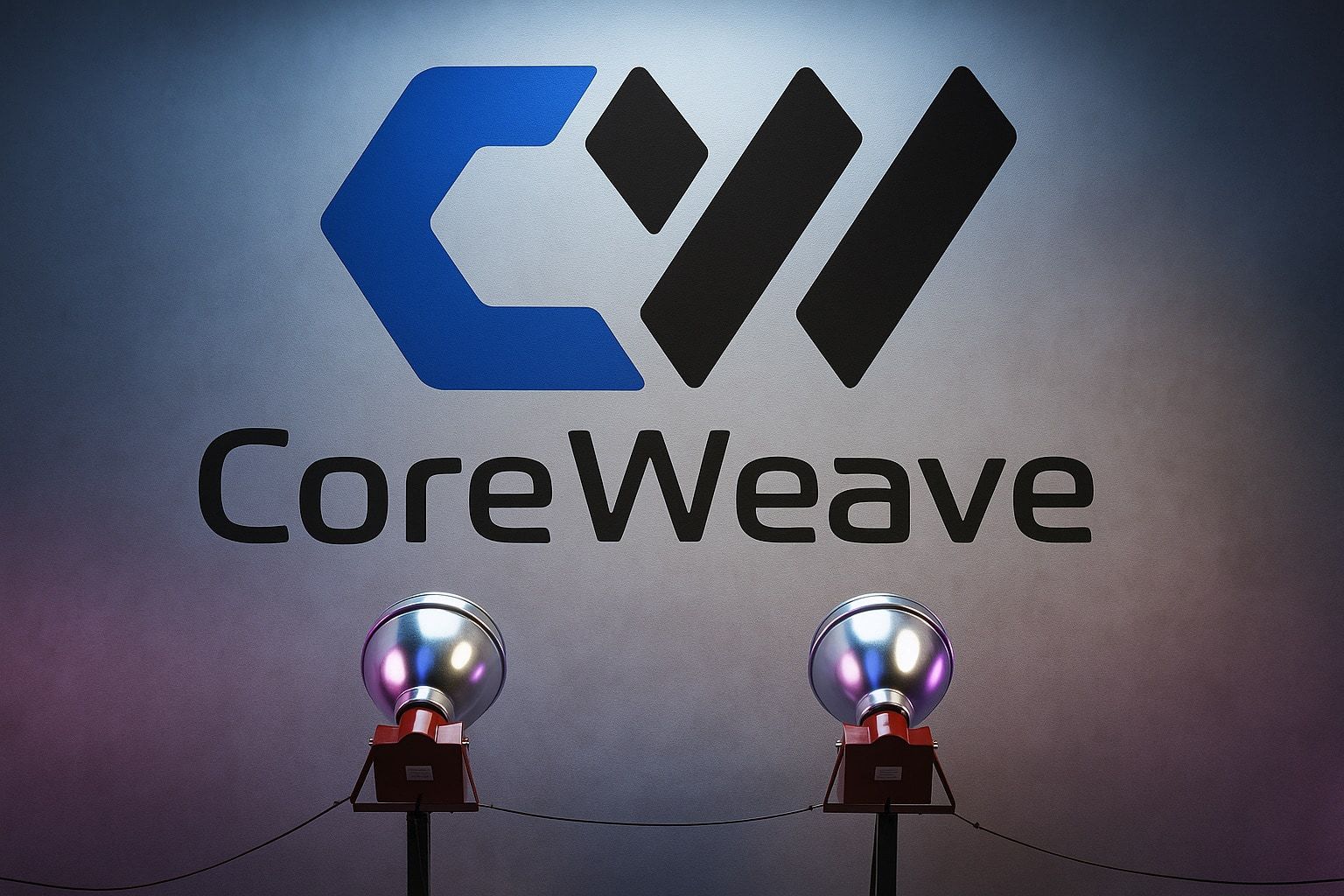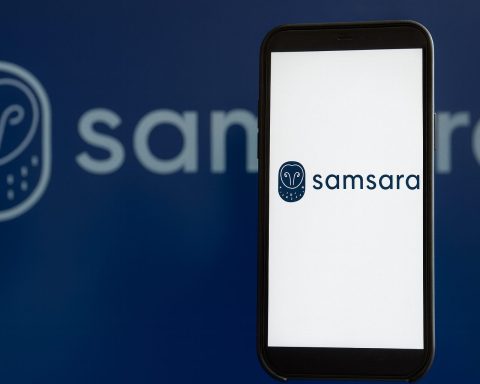CoreWeave (NASDAQ: CRWV) has gone from market darling to high‑beta rollercoaster in just a few weeks. After a blockbuster third‑quarter earnings beat but a small cut to 2025 guidance, the Nvidia‑backed AI cloud provider is now at the center of a fierce debate about whether we’re in an AI infrastructure bubble – and whether CRWV is a buy‑the‑dip opportunity or a ticking time bomb.
As of the close on Friday, 14 November 2025, CoreWeave shares finished at $77.36, down about 25–26% over the past week and roughly 45% below their mid‑October peak, leaving the company valued around $38.5 billion. [1]
Key takeaways on CRWV stock today (16 November 2025)
- Price & performance: CRWV closed at $77.36 on Friday, down 1.25% on the day, ~26% over the last week and more than 40% over the past month. The 52‑week range is $33.52 to $187.00, so the stock now trades about 59% below its high. [2]
- Q3 2025 results: Revenue more than doubled year‑over‑year to $1.36 billion, beating estimates, with adjusted EBITDA margin of 61% and revenue backlog soaring to $55.6 billion. [3]
- Guidance cut & data‑center delay: Management trimmed 2025 revenue guidance to $5.05–$5.15 billion (from $5.15–$5.35 billion) due to a delay at a third‑party data‑center developer, not demand. [4]
- AI bubble narrative: A high‑profile Verge piece dubbed CoreWeave “the company at the heart of the AI bubble,” and coverage of that story triggered an 8%+ single‑day drop in CRWV. [5]
- Financing & leverage: CoreWeave carries roughly $14 billion in debt, negative free cash flow and has just increased its revolving credit facility from $1.5B to $2.5B, extending maturity to 2029. [6]
- Credit risk jitters: A recent Barron’s piece notes that five‑year credit‑default swap prices on CoreWeave debt have jumped over 50% since October, as the stock slid 56% from its June peak, reflecting rising concern over leverage and AI capex sustainability. [7]
- Wall Street view: Despite the sell‑off, around 25–26 analysts still rate CRWV a “Buy”, with average 12‑month targets clustered around $128–$140 – implying roughly 60–80% upside from current levels – though a few firms have moved to Neutral/Underperform. [8]
CRWV stock price today: where CoreWeave stands after the sell‑off
From an AI‑boom high‑flyer to a bruised growth stock, CoreWeave’s near‑term price story is all about compression of expectations.
At Friday’s close:
- Share price: $77.36
- Market cap: ≈ $38.55 billion [9]
- TTM revenue: ≈ $4.31 billion
- TTM net loss: ≈ –$825 million (EPS –$2.32)
- Price‑to‑sales (TTM): roughly 9×
- 52‑week range: $33.52 – $187.00 [10]
Based on management’s 2025 revenue outlook of $5.05–$5.15 billion, the stock now trades at about 7.5–7.7× forward sales, still rich versus most cloud peers but dramatically lower than at its peak. [11]
According to Quiver Quantitative, CRWV has been one of the most‑searched tickers on its platform this week and is down about 26% over that period, highlighting just how fast sentiment has flipped. [12]
November 2025 news recap: how we got here
1. Q3 2025: revenue boom, small guidance cut
On 10 November 2025, CoreWeave reported Q3 2025 results:
- Revenue: $1.36 billion, up from $583.9 million a year earlier (+134%) and ahead of the $1.29 billionconsensus. [13]
- Operating income: $51.9 million, but operating margin fell from 20% to 4% as expenses scaled. [14]
- Net loss: narrowed to –$110 million (–8% margin) from –$360 million (–62% margin) a year earlier. [15]
- Adjusted EBITDA: $838 million, a 61% margin. [16]
- Revenue backlog: $55.6 billion, almost double the prior quarter, driven by multi‑year deals including a $14.2 billion agreement with Meta and an additional $6.5 billion OpenAI deal, bringing total OpenAI commitments to $22.4 billion. [17]
That’s explosive growth by any standard. But management also:
- Lowered 2025 revenue guidance to $5.05–$5.15 billion (from $5.15–$5.35 billion, and below the roughly $5.29 billion Street consensus).
- Blamed a delay at a third‑party data‑center developer, emphasizing that the affected customer agreed to extend the contract, preserving total deal value. [18]
- Indicated capital expenditures of $12–$14 billion this year, with capex expected to more than double again next year, underscoring the capital‑intensive nature of the business. [19]
Media coverage from outlets like Fast Company, CNBC and Bloomberg quickly framed the sell‑off as a “one data center problem” colliding with AI hype and stretched valuations. [20]
2. AI bubble spotlight: The Verge & TipRanks
On 13 November, The Verge published a feature and podcast describing CoreWeave as “the company at the heart of the AI bubble”, highlighting its roots as an Ethereum miner, its pivot into AI infrastructure, and its strategy of using heavy structured financing to build GPU‑rich data centers and lease capacity to AI leaders. [21]
Shortly after, a TipRanks piece noted that CRWV fell over 8% in a single session after The Verge’s framing fueled worries that the stock’s roughly $50 billion valuation had run ahead of fundamentals. [22]
This narrative – “CoreWeave as the pure‑play proxy for the AI bubble” – has clearly spooked momentum traders who were happy to own the stock on the way up.
3. Barron’s and the cost of insuring CoreWeave’s debt
A Barron’s article on 14 November added fuel by focusing on credit risk rather than just stock volatility:
- CoreWeave shares have fallen more than 40% in the last month and 56% from their June record high, despite still‑strong AI demand.
- The price of five‑year credit‑default swaps on CoreWeave debt has jumped over 53% since October, signalling that bond markets are increasingly nervous about its high leverage and negative free cash flow. [23]
The article stressed that because CoreWeave funds its build‑out largely with debt secured by long‑term customer contracts, any slump in equity value raises leverage ratios and intensifies market concerns – a feedback loop that can amplify volatility. [24]
4. JPMorgan downgrade and split sell‑side sentiment
On 11 November, J.P. Morgan downgraded CoreWeave from “Overweight” to “Neutral” while still assigning a $110 price target, which implied upside versus where the stock was trading at the time. [25]
QuiverQuant data shows:
- 12 firms rating CRWV as a “Buy” and 2 with “Sell/Underperform” ratings.
- 25 analysts have issued price targets in the last six months, with a median target around $140. [26]
StockAnalysis aggregates 26 analysts with an average target of $127.91 (about 65% above Friday’s close) and an overall “Buy” consensus. [27]
In other words, Wall Street broadly still likes the story, but the downgrade and widening range of opinions show that the market is recalibrating risk.
Fundamentals: hyper‑growth meets heavy capex
Revenue and profitability trajectory
From a financial perspective, CoreWeave is still in the “grow at all costs” phase:
- 2024 revenue: about $1.9 billion, up more than 700% from 2023, but with a $863 million net loss. [28]
- TTM revenue: ≈ $4.31 billion, with TTM net loss of about $825 million. [29]
- Q3 2025: strong positive operating cash flow (~$1.69 billion) but negative free cash flow (~–$1.6 billion)because the company spent nearly $3.3 billion on capex. [30]
This is a classic infrastructure land‑grab: huge upfront capex in exchange for long‑dated contracts.
Debt, credit lines and liquidity
CoreWeave’s growth is funded by considerable leverage:
- It had around $8 billion of debt at the end of last year, with about 32% of net cash flow going to debt service, according to its IPO filings. [31]
- The company recently raised $1.75 billion of 9.0% senior unsecured notes due 2031 and added billions in delayed‑draw term loans. [32]
- As of Q3, it held about $1.9 billion in unrestricted cash and investments and roughly $14 billion in debt. [33]
- On 12 November, CoreWeave expanded its revolving credit facility from $1.5B to $2.5B and extended the maturity from May 2028 to November 2029, led by a syndicate of major banks including JPMorgan, Goldman Sachs, Morgan Stanley and MUFG – signalling continued lender confidence despite market jitters. [34]
The balance sheet is aggressive but not obviously broken: management argues that capex is “success‑based”, tied to contracted customer demand, and backed by a backlog of $55.6 billion in future revenue. [35]
Customer concentration and competitive landscape
CoreWeave is deeply intertwined with Big Tech:
- Microsoft accounted for about 62% of 2024 revenue, according to its IPO prospectus, highlighting significant customer concentration risk. [36]
- The company depends heavily on Nvidia GPUs and competes against hyperscalers such as AWS, Google Cloud, Azure and Oracle, as well as smaller AI‑focused clouds like Crusoe and Lambda. [37]
That combination – one very large customer, one dominant supplier and giant competitors – is a double‑edged sword: it brings scale quickly but also magnifies any disruption in those relationships.
November positive catalysts: new product and more firepower
Amid the turmoil, CoreWeave has rolled out several strategic positives in November:
Zero Egress Migration (0EM) program
On 13 November, CoreWeave launched Zero Egress Migration (0EM), a program that:
- Covers data‑egress fees for customers migrating AI workloads from other major clouds (AWS, Azure, Google Cloud, IBM, Alibaba and others).
- Provides a fully managed, secure, high‑speed migration path, boasting 7 GB/s per GPU throughput via its Local Object Transport Accelerator (LOTA) technology. [38]
For large AI workloads, egress fees can run into millions of dollars, so absorbing those costs and simplifying multi‑cloud setups may be a meaningful competitive wedge against hyperscalers. [39]
Expanded revolving credit facility
The $1 billion increase in CoreWeave’s revolving credit line gives management extra flexibility to:
- Bridge timing gaps between capex and cash inflows.
- Smooth over any future project delays similar to the current data‑center issue. [40]
The facility’s extension to 2029 also reduces near‑term refinancing risk and signals that big banks are willing to keep funding the AI build‑out, even as equity markets wobble.
Performance and ecosystem credibility
CoreWeave also continues to rack up badges of technical prestige:
- It is the only AI cloud to achieve the top Platinum ranking in both SemiAnalysis ClusterMAX 1.0 and 2.0, highlighting performance and efficiency. [41]
- It has launched features like ServerlessRL for reinforcement‑learning workloads and signed partnerships such as CrowdStrike + CoreWeave’s “Secure AI Cloud for the Agentic Era.” [42]
These moves support the “essential AI infrastructure” narrative that bulls rely on.
Sentiment check: insiders vs institutions vs analysts
Heavy insider selling
QuiverQuant data reveals 1,637 insider stock transactions over the last six months – all of them sales, zero purchases. Large holders such as Magnetar Financial and multiple co‑founders have taken substantial profits post‑IPO. [43]
That doesn’t automatically mean insiders are bearish – it’s common after a hot IPO – but combined with the stock’s volatility, it doesn’t help confidence.
Institutions piling in (and out)
On the other hand, institutional ownership has grown:
- 378 institutions increased positions in CRWV recently, while 101 decreased.
- New or larger holders include Vanguard, Morgan Stanley, Invesco and other big funds adding millions of shares. [44]
This suggests that large investors still see CoreWeave as a core AI infrastructure play, even if they expect turbulence.
Analyst targets and the risk‑reward debate
Between StockAnalysis, Fintel and Quiver, we see:
- Consensus rating: “Buy”.
- Average / median 12‑month target: roughly $128–$140, which is 60–80% above Friday’s close. [45]
- Target range: from low ~$36 to high ~$245, indicating massive disagreement on long‑term outcomes. [46]
Recent commentary from outlets like The Motley Fool/Nasdaq describes CoreWeave as a “highly speculative” play where the economics of AI data centers – especially hardware useful life and return on capex – are still unproven. [47]
CRWV stock forecast: scenarios for 2026–2027
Important: The following is not a prediction or personalized advice. These are illustrative scenarios, based on public data and current sentiment.
Starting point
- 2025 revenue guidance: $5.05–$5.15 billion. [48]
- Backlog: $55.6 billion, with multiyear contracts from Meta, OpenAI and others. [49]
- Current valuation: about 7.5× forward 2025 sales and ~9× trailing sales at a $38.5B market cap. [50]
With that in mind:
1. Base‑case (probable but still volatile)
Assumptions
- AI infrastructure demand remains strong, but growth moderates from “hyper‑parabolic” to high double‑digitannual revenue growth in 2026–2027.
- The delayed data center comes online on a revised schedule and no major new delays emerge.
- Margins stabilize as scale offsets some capex‑driven cost pressure.
Implications
- Revenue could plausibly reach the $7–8 billion range by 2027 under continued high growth (this is not company guidance, just a directional assumption).
- If the market is comfortable valuing CoreWeave at 6–8× forward sales once execution risk feels lower, that implies a market cap range roughly in line with, or moderately above, today’s – say $40–60 billion.
Translated into very rough price terms, that would be consistent with CRWV trading somewhere around the $100–$150band over the next couple of years – broadly in line with current analyst targets – but with big swings along the way.
2. Bull‑case (AI super‑cycle + flawless execution)
Assumptions
- AI model sizes and workloads continue to explode; demand for GPU‑heavy infrastructure remains undersupplied.
- CoreWeave converts backlog efficiently, adds new mega‑deals and maintains its performance lead (e.g., ClusterMAX Platinum ratings, 0EM migrations). [51]
- Financing conditions remain friendly; credit markets stay open despite high leverage.
Implications
- Revenue could push toward or beyond $10 billion later in the decade.
- The stock might regain a premium multiple (8–10× forward sales) if investors are convinced the backlog will translate into durable free‑cash‑flow growth.
In that scenario, it’s not hard to see why some price targets stretch into the $180–$200+ range, roughly matching the top of today’s analyst target band. [52]
3. Bear‑case (AI bubble pops / credit squeeze)
Assumptions
- AI infrastructure spending slows or becomes more price‑competitive; Big Tech reins in capex or shifts more workloads in‑house.
- Further project delays or cost overruns hit CoreWeave’s margins and shake confidence in its “success‑based capex” model.
- Rising interest rates or credit concerns make refinancing much more expensive, with CDS markets already hinting at rising perceived default risk. [53]
Implications
- The market may compress the valuation multiple significantly (e.g., 3–5× sales), especially if growth slows.
- In a harsher environment, CRWV could retest or even break below its $40 IPO price, particularly if equity markets demand deleveraging or fresh capital at unattractive terms. [54]
Given the combination of high leverage, negative free cash flow and AI‑cycle uncertainty, the downside is substantialif the bull case fails to materialize.
What to watch next
For anyone tracking CRWV (whether as a current or prospective investor), the next few weeks and months bring several potential catalysts:
- Wells Fargo TMT Conference (18 November 2025): CFO Nitin Agrawal is scheduled to present; markets will be listening for updated commentary on the delayed data center, capex plans and demand trends. [55]
- Updates on the delayed facility: Any concrete timeline from CoreWeave or the third‑party developer could help investors re‑anchor expectations.
- New contracts or expansions: Additional large‑scale deals (or renewals) with hyperscalers or AI labs would reinforce the backlog story. [56]
- Debt market signals: Movements in CoreWeave’s CDS spreads and bond yields will be a key barometer of how credit markets view its risk profile. [57]
Bottom line: who is CRWV really for?
CoreWeave today is not a steady compounder. It’s a high‑beta, high‑leverage, AI‑infrastructure pure play with:
- Exceptional top‑line growth and a huge backlog,
- A capital‑intensive model that depends on cheap financing and execution, and
- A growing narrative overhang about an AI bubble and the sustainability of AI data‑center economics. [58]
For risk‑tolerant investors who believe the AI infrastructure super‑cycle still has years to run, the current sell‑off may look like an opportunity to scale into a speculative position, especially relative to Wall Street’s 12‑month target band.
For more conservative investors, the combination of:
- Heavy leverage,
- Negative free cash flow,
- Rising credit‑risk pricing, and
- Narrative risk around an “AI bubble”
may justify staying on the sidelines or limiting exposure until the dust settles.
Disclosure: This article is for informational and educational purposes only and does not constitute financial advice, investment recommendation, or an offer to buy or sell any securities. Always do your own research and consider consulting a licensed financial adviser before making investment decisions.
References
1. stockanalysis.com, 2. stockanalysis.com, 3. investors.coreweave.com, 4. www.reuters.com, 5. www.theverge.com, 6. www.nasdaq.com, 7. www.barrons.com, 8. stockanalysis.com, 9. stockanalysis.com, 10. stockanalysis.com, 11. www.reuters.com, 12. www.quiverquant.com, 13. investors.coreweave.com, 14. investors.coreweave.com, 15. investors.coreweave.com, 16. investors.coreweave.com, 17. investors.coreweave.com, 18. www.reuters.com, 19. www.reuters.com, 20. stockanalysis.com, 21. www.theverge.com, 22. www.tipranks.com, 23. www.barrons.com, 24. www.barrons.com, 25. fintel.io, 26. www.quiverquant.com, 27. stockanalysis.com, 28. www.investopedia.com, 29. stockanalysis.com, 30. www.nasdaq.com, 31. www.investopedia.com, 32. investors.coreweave.com, 33. www.nasdaq.com, 34. investors.coreweave.com, 35. investors.coreweave.com, 36. www.investopedia.com, 37. www.investopedia.com, 38. www.stocktitan.net, 39. www.stocktitan.net, 40. investors.coreweave.com, 41. www.stocktitan.net, 42. www.stocktitan.net, 43. www.quiverquant.com, 44. www.quiverquant.com, 45. stockanalysis.com, 46. fintel.io, 47. www.nasdaq.com, 48. www.reuters.com, 49. investors.coreweave.com, 50. stockanalysis.com, 51. www.stocktitan.net, 52. www.quiverquant.com, 53. www.barrons.com, 54. www.investopedia.com, 55. stockanalysis.com, 56. investors.coreweave.com, 57. www.barrons.com, 58. investors.coreweave.com







